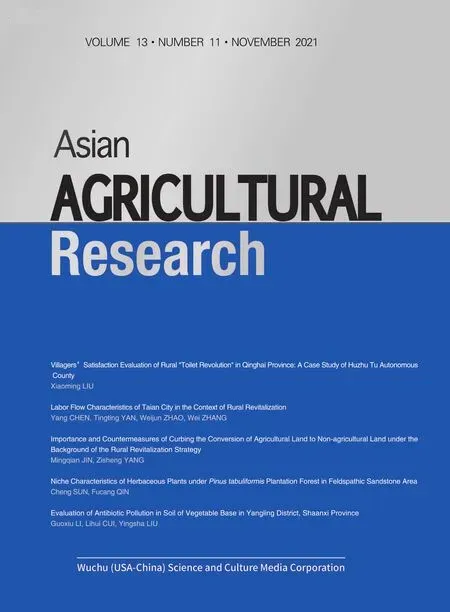Labor Flow Characteristics of Taian City in the Context of Rural Revitalization
2021-12-30YangCHENTingtingYANWeijunZHAOWeiZHANG
Yang CHEN, Tingting YAN, Weijun ZHAO, Wei ZHANG
1. Weihai Futai Middle School, Weihai 264200, China; 2. School of Tourism, Taishan University, Taian 271000, China; 3. School of Civil and Architectural Engineering, Shandong University of Technology, Zibo 255000, China; 4. Ludong Branch of Qingdao Engineering Consulting Institute, Weihai 264200, China
Abstract [Objectives] To analyze and study the characteristics of rural labor flow to the tourism industry in Taian City of Shandong Province, and propose some measures for solving the problems of labor support in the development of rural tourism in Taian City. [Methods] The indicators were analyzed using the time series based on the relevant data on the labor employment and flow of rural households in Taian City in 2005-2013. [Results] In Taian City, the number of rural laborers engaged in the primary industry decreased at the rate of 96 people/year, while the number of laborers engaged in the secondary and tertiary industries increased at the rate of 29 people/year and 3 people/year, respectively. The proportion of the three traditional tourism elements of transportation, lodging and catering in the tourism industry has been fluctuating, and the minimum was not lower than 30%. The recreational category was decreasing year by year, and only accounted for 1.7% in 2010. In summary, in the development of rural tourism in Taian City, the labor flow has problems such as low rural social security, weak attraction to young people, and large psychological barriers to returning to the hometown for employment. [Conclusions] In view of the problems, it is recommended to implement the rural revitalization strategy, attach importance to regional labor competition, give full play to the advantages of tourist cities, highlight product characteristics, increase cultural added value and improve the quality of operators to develop rural tourism. This study is intended to provide a scientific reference for talent support for rural revitalization in Taian City.
Key words Rural labor, Tourism industry, Rural tourism, Rural revitalization, Taian City
1 Introduction
In the report of the 19National Congress of the Communist Party of China, General Secretary Xi Jinping proposed the rural revitalization strategy, insisting on giving priority to the development of agriculture and rural areas, supporting migrant workers in cities to return to their hometowns to start businesses, to promote the development of new industries and businesses in rural areas. Besides, it encourages all kinds of talents such as college graduates, business owners, and returned overseas students to return to their hometowns to start businesses and innovate. Taian City implemented theAction
Plan
of
Rural
Tourism
Poverty
Alleviation
Project
issued by China National Tourism Administration and included 72 villages into the national villages for rural tourism poverty alleviation. To realize the rural revitalization, it is necessary to give full play to the role of rural tourism. Despite the support of various policies, the development of rural tourism in Taian City still needs more human and financial support, which provides employment opportunities for rural labor. From both the national level to the city level, it has expressed the important role and significance of the return of labor at different levels to rural revitalization. Therefore, studying the characteristics of rural labor flow in Taian is of great significance to the overall revitalization of the rural areas. The flow and transfer of rural labor in China is a prominent phenomenon in the current economic and social development. At present, many domestic scholars have conducted extensive studies on the flow of rural labor in China. Zhang Guangshenget
al.
reviewed the history, characteristics and urbanization process of rural labor flow in the past 40 years since the reform and opening up, analyzed the causes of labor flow, and estimated the contribution of rural labor flow to the national economy, and put forward policy recommendations in line with the existing problems. Using the fuzzy decision-making method, Chen Fangmeiet
al.
conducted related research on the decision changes of Sichuan farmers on their choice to flow to Guangdong or Zhejiang, analyzed the factors influencing the flow direction of farmers, and constructed a fuzzy multi-attribute decision-making model based on the movement function, and revealed the current regional competition for labor in China according to the research findings. Wu Fangweiet
al.
studied the impact of regional economic growth on the transfer of labor flow. Ji Qinet
al.
studied the contribution of Guizhou’s labor flow to economic growth. Tian Fuqianganalyzed and discussed the rural labor flow in Shaanxi Province. Domestic scholars conducted research and discussion on the rural labor flow mainly from the economic perspective, and there are few studies on the rural labor flow based on the rural revitalization policy (mainly tourism industry). In this situation, the research on the rural labor flow becomes increasingly important.Relying on Mount Tai (Taishan Mountain) and other influential tourism brands, the cultural characteristics of Mount Tai,etc.
, and based on the data of rural labor flow in Taian City, we analyzed the characteristics of the rural labor flow to three major industries, and discussed the driving factors of the characteristics of the flow, to provide a scientific basis for Taian City to formulate a scientific and reasonable implementation plan for rural revitalization.2 Data and methods
Through consulting theTaian
Statistical
Yearbook
(2005-2013), we obtained relevant data on labor flow in Taian City in recent years, and summarized and analyzed these data with the aid of Excel software. In this study, we mainly used the regression analysis method and the statistics and chart functions of Excel software. Besides, using the time series analysis indicators, we analyzed the trend and rules of the rural labor flow in Taian City in the context of the rural revitalization policy. These analysis indicators include: the analysis of the labor force in three major industries of Taian City and the analysis of the labor flow to the tourism industry and the tertiary industry. In addition to the regression analysis, we also used methods such as comparative analysis and proportional calculation (Formula 1), to better understand the characteristics of the rural labor flow in Taian City.
(1)
wherea
refers to the six elements of transportation, travel, accommodation, catering, shopping, and recreation,b
denotes the tourism industry and the tertiary industry, andx
represents the proportion of the six elements in the tourism industry or the tertiary industry.3 Results and analysis
3.1 Basic characteristics of the industrial distribution of rural labor flow
3.1.1
Analysis on the rural labor engaged in the primary industry. Relevant data from the survey on labor employment and flow of rural households in Taian City in 2005-2013 indicate that the number of people engaged in the primary industry decreased year by year (Fig.1). From the linear regression equation, it can be seen thatR
=0.947 4, the fitting degree is good, there is a linear relationship, and the year and the number of people are positively correlated. With the increase in the number of years, it shows a decreasing trend at the rate of 96 people/year. With the continuous development of economy and technology, the acceleration of the reform and opening up process, the urbanization level of Taian City has been accelerating. In 2013, the urban population of Taian City was 2.994 million, and the urbanization rate reached 53.76%. People’s living standards are constantly improving. The rural labor flow is restricted by the productivity development level. As a city in the central area of Shandong Province, Taian City still has certain shortcomings relative to the urban development of Qingdao City and other eastern Shandong regions. The eastern coastal regions are at the forefront of reform and opening up, and they are more attractive to labor relying on advantageous conditions such as the market, capital, and wage level. In addition, most rural areas use agricultural machinery for production and farming. The increase in the utilization rate of agricultural machinery has led to an increase in agricultural productivity and reduced the participation of rural labor. Furthermore, the development of the educational environment and conditions promotes more young people to go out of the rural areas, learn scientific and cultural knowledge, and master skills. Most rural labors choose to go out to work instead of farming in the village, leading to the transfer of labor to the secondary and tertiary industries.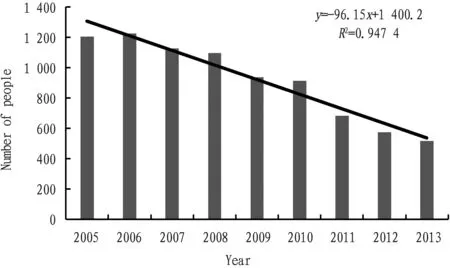
Fig.1 Rural labor of Taian City engaged in the primary industry
3.1.2
Analysis on the rural labor engaged in the secondary industry. Relevant data from the survey on labor employment and flow of rural households in Taian City in 2005-2013 indicate that the number of rural labor engaged in the secondary industry increased year by year. We selected representative sectors of secondary industry, namely, mining, manufacturing, and construction as examples (Table 1), and used the total number of the three sectors to represent the secondary industry to make a linear regression analysis (Fig.2). According to the linear regression equation, it can be seen thatR
=0.643 3, the number of laborers engaged in the secondary industry increased at the rate of 29 people/year and the development trend is strong. The reason for the increase in the number of people is the rapid economic development, which makes the industrial structure reasonable adjustment and optimization. The secondary industry is mostly capital, technology and labor-intensive industries. This type of industry mostly exists in coastal regions and areas with rapid economic development. Through the establishment of various development zones, these regions have become developed areas with a high level of industry and a complete structure, attracting a large number of rural laborers to engage in this industry. At the same time of a large number of rural labor flowing, the size and number of cities and towns in these regions are expanding rapidly. The development of economy, the progress of people’s thinking and education, more and more people go out of the rural areas, receive higher education and training, learn science and technology, which promote the development of the secondary industry, and drive the economic progress of Taian City.
Table 1 Rural labor of Taian City engaged in the secondary industry (people)

Fig.2 Linear regression of rural labor of Taian City engaged in the secondary industry
3.1.3
Analysis on the rural labor engaged in the tertiary industry. Relevant data from the survey on labor employment and flow of rural households in Taian City in 2005-2013 indicate that the number of people engaged in the tertiary industry gradually increased with certain fluctuation. We selected representative sectors of tertiary industry, including transportation, warehousing, post and telecommunications, accommodation, and catering as examples (Table 2). Then, we made a linear regression analysis (Fig.3).R
=0.560 3, indicating that the degree of fitting is good, and there is a certain linear relationship. The number of rural laborers engaged in the tertiary industry in Taian City increased at a rate of 3 people/year. For one reason, with the progress of industrialization, material production has been greatly developed, the market economy has developed, and the market has continued to develop. The development of material production has increased the social demand for the tertiary industry. The tertiary industry has been developed in a supporting manner. For another reason, with the increase of national income, in addition to meeting basic living needs, more needs are shifting to non-material needs, that is, cultural, education, entertainment and other spiritual needs have greatly increased. These needs are met largely by the development of the tertiary industry, and the development of the tertiary industry attracts more people to engage in this industry. The support of national and provincial rural revitalization and tourism policies has led to the development of rural tourism. As a tourist city dominated by Mount Tai, the rapid development of rural tourism in Taian has simultaneously promoted agricultural modernization in the in-depth development of industrialization and urbanization, promoted the construction of a new socialist countryside in Taian, and promoted development of many sectors of agriculture, rural scenic spots, and promoted farmers’ diverse jobs, and resources becoming products, provided certain employment opportunities for rural surplus labor, and injected new vitality into rural areas.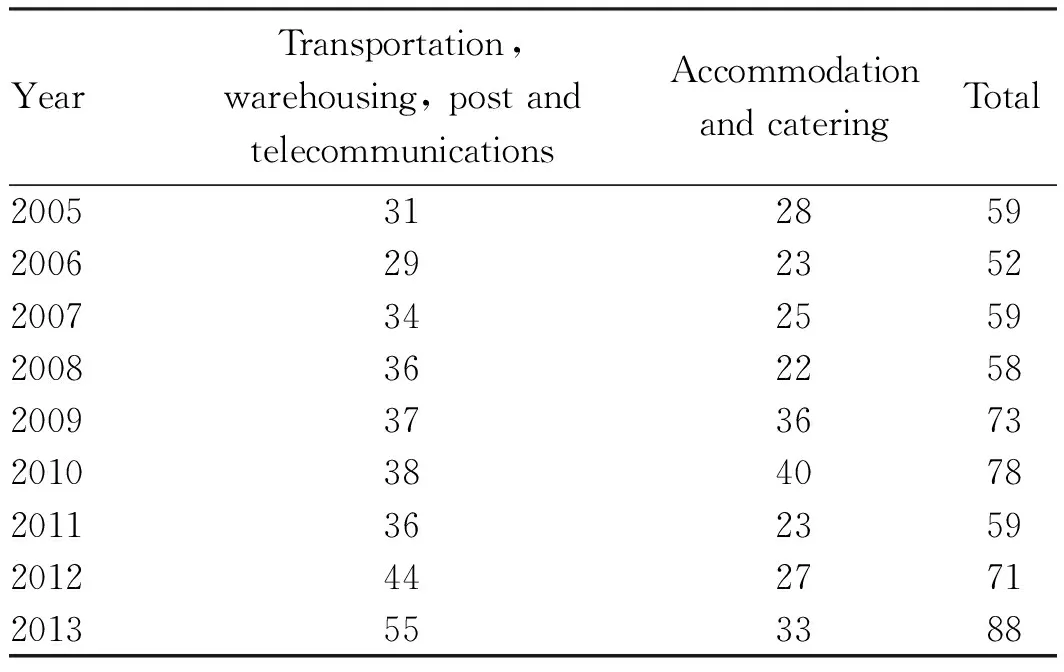
Table 2 Rural labor of Taian City engaged in the tertiary industry (people)
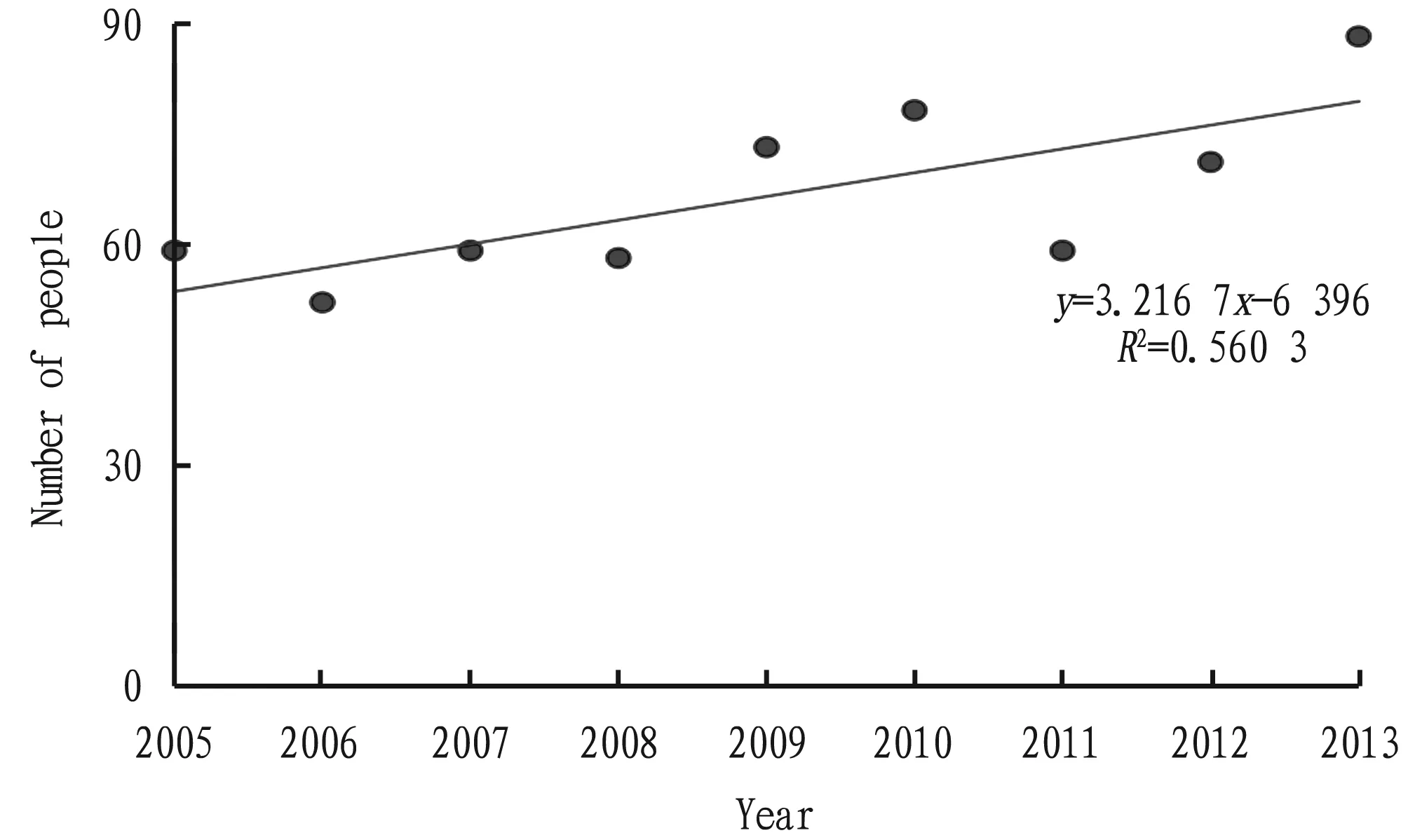
Fig.3 Linear regression of rural labor of Taian City engaged in the tertiary industry
3.2 Characteristics of the rural labor flow to the tourism industry
3.2.1
Time change characteristics of elements. The tourism industry belongs to the tertiary industry, a new type of labor-intensive industry, and has a greater demand for simple labor. The tourism industry is composed of three parts: transportation and passenger transportation, tourism, and the accommodation industry represented by hotels. They are the three pillars of the tourism industry. Fig.4 shows the time change of the rural labor flow to the tourism industry. The tourism industry is represented by the transportation industry, the accommodation and catering industry, and the cultural and recreation industry. From Fig.4, it can be seen that the number of rural laborers flowing to the transportation industry has increased year by year, reaching 55 people in 2013, suggesting that the transportation industry, as a basic industry in the tourism industry, is attracted by its low technical difficulty and qualifications, and most of the rural labor is engaged in this industry. The number of people flowing to the accommodation and catering industry has obvious fluctuation, reaching the highest value of 40 people in 2010, indicating that accommodation and catering are indispensable in every city and every region. Accommodation and catering are two of the six major elements of tourism and are an indispensable part. Therefore, the attractiveness of the accommodation and catering industry to rural labor is relatively stable and fluctuates significantly. By comparison, the number of people flowing to the cultural and recreation industry is gradually decreasing. These indicate that the transportation industry, as a basic industry, has a good momentum of development, and the development of the tourism industry is inseparable from the development of the transportation industry. The urbanization process of Taian City is accelerating, the education level and self-ideological level are improving, and more people are engaged in mental work instead of physical work. The rural revitalization policies promulgated at the national, provincial and municipal levels have promoted the rapid development of rural tourism, requiring a large amount of human and financial support to promote the return of rural labor. The traditional cultural and recreation industry is no longer attractive, but the new type of rural tourism attracts more producers and laborers. The identity of farmers has changed from farmer to both farmer and merchant, and farmers can operate independently, prompting farmers to vigorously develop sightseeing agriculture, ecological agriculture and fine-product agriculture.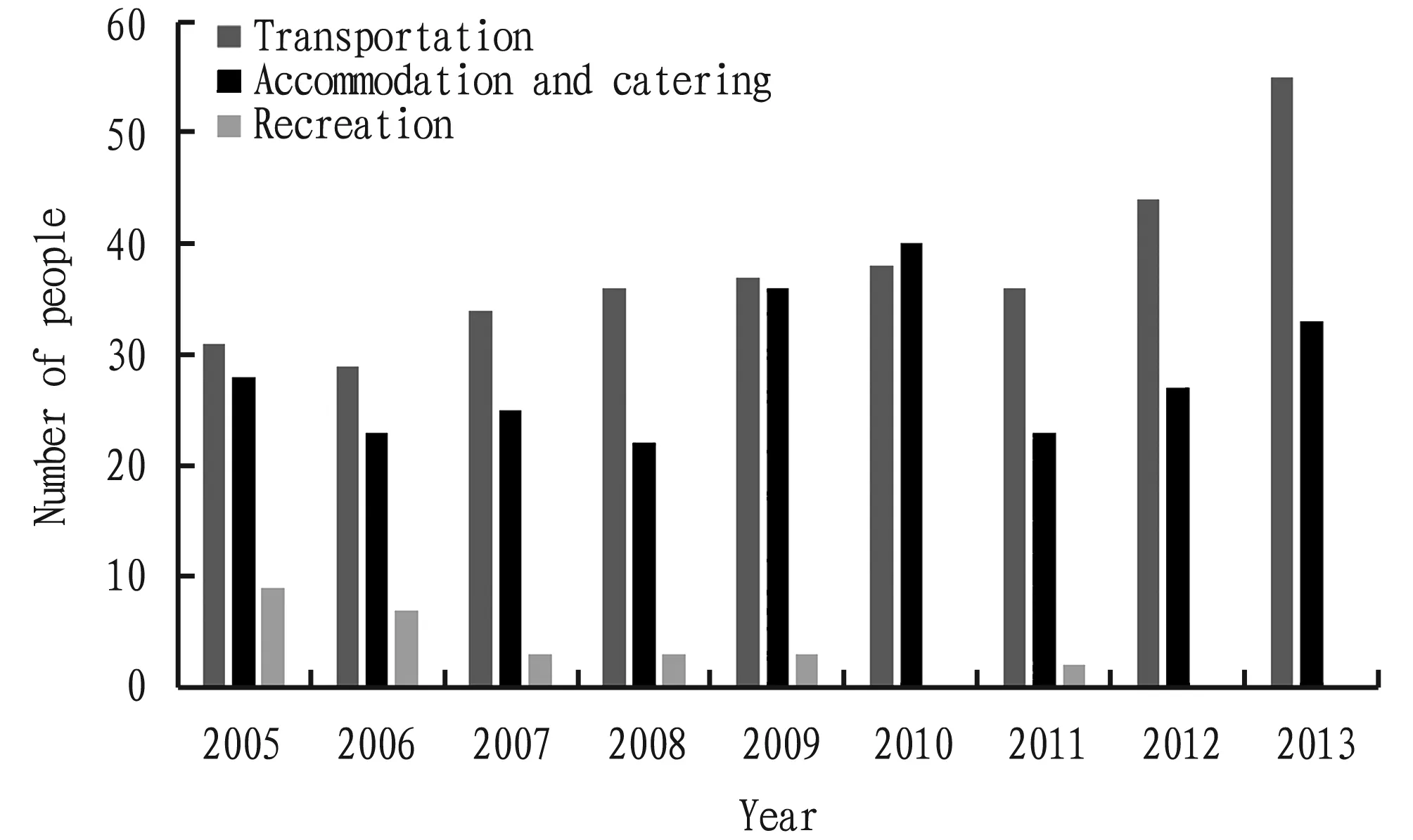
Fig.4 Time changes in the flow of rural labor to the tourism industry
3.2.2
Structural characteristics of labor flow to tourism industry. The tourism industry is composed of tourism, transportation and the accommodation industry represented by hotels. Transportation, travel, accommodation, catering, shopping, and recreation are the six major elements of the tourism industry. We selected the four representative elements of transportation, accommodation, catering and recreation as examples (Fig.5), and calculated the proportions of these four elements in the tourism industry using formulas. From Fig.5, it can be seen that the proportion of transportation, accommodation, catering in the tourism industry has fluctuation, and the minimum is not less than 30%. The recreation is decreasing year by year, accounting for only 1.7% in 2010. These indicate that accommodation and catering account for a larger portion in the tourism industry. The accommodation and catering mainly exist in urban areas. The speed of urbanization affects the development of the accommodation and catering industry. The decline in recreation year by year is that due to the economic development and the increase in residents’ income, people are no longer satisfied with the material needs of life, and thus turn to cultural and spiritual needs. The decline in the proportion of single element (recreation) in the tourism industry in recent years is due to the fact that the quality, system and mechanism of Chinese enterprises are facing the challenge of rapid improvement. Many Chinese companies have problems in operating mechanisms, self-discipline mechanisms, risk awareness, and management capabilities.
Fig.5 Proportion of single element in the tourism industry
In addition, using Formula (1), we calculated the proportion of single element (transportation, accommodation, catering, and recreation) in the tertiary industry. From Fig.6, it can be seen that the representative transportation industry has generally grown, accounting for 62.5% by 2013. These indicate that with the improvement of the production efficiency of the primary and secondary industries, the growth of demand for the tertiary industry has further accelerated. Transportation is the foundation of the national economy. The faster the level of production and the higher the degree of modernization, the more complete the transportation infrastructure is required. Accommodation and catering show fluctuation, and their proportion in the tertiary industry is generally on a declining trend. The reason is that China’s accommodation and catering industry is large in number but not sophisticated, its comprehensive strength is not strong, its market competitiveness is weak, and its ability to withstand risks is very low. Most accommodation and catering companies have traditional business models, with a high degree of market assimilation, weak development efforts, a single product structure, and weak innovation capabilities. The decline in cultural and recreation elements year by year is due to the weak legal awareness of operators, imperfect management system, unreasonable industrial and market structure, serious duplication of construction, as well as people’s pursuit of deeper needs, and traditional cultural recreation is no longer attractive.
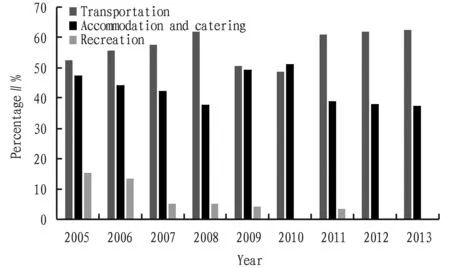
Fig.6 Proportion of single element in the tertiary industry
4 Problems and recommendations for labor driving factors in the development of rural tourism in Taian City
4.1 Problems
Rural tourism takes the rural area and the rural customs related to agriculture as the attraction, attracting tourists to go for sightseeing experience. Taian City has excellent resource advantages and market prospects. As early as in 1991, Buyang Village in Daiyue District started to develop rural tourism. There are various types and different forms of rural tourism. Basically there are three types: one is traditional sightseeing, this type relies on beautiful natural scenery, agricultural industry advantages and rich folk customs to attract tourists to visit and participate in the experience, eat farm meals, live in farm houses, doing farm work, and undertake tourism activities such as picking; the second type is the catering and recreation, this type relies on the location advantage of the suburbs and the ecological advantage of agricultural products to attract urban residents’ catering consumption; the third is the festival participation type, this type relies on traditional rural festivals derived from religion, products, recreation,etc.
, to form distinctive rural tourism products. The development of rural tourism has a great influence on labor flow. Its development, to a certain extent, has solved the employment problem of passive return population, and attracted outstanding talents from some cities to participate in the construction of new rural areas and revitalize the countryside. In this process, they comprehensively considered material and spiritual factors, and finally decided whether to return. Government encouragement and policy support became an important pulling force when they made the decision on return. At present, the labor flow has following problems. (i) The proportion of young people is relatively small. Rural tourism still remains in the initial stage of development, and there are many defects and deficiencies in the development model. The types of tourism projects are few, jobs are single and mainly low level, the opportunities for job promotion are few. (ii) There are large psychological barriers to returning hometown for construction. Most people feel that returning to their hometowns for employment cannot meet their social and development needs and thus lack enthusiasm. (iii) The basic social security such as pension and medical care in most rural areas is low, so they are unwilling to return to their hometowns for employment. (iv) Surplus labor hinders the development of rural tourism. Due to various factors such as historical economy, operators have a low level of education.4.2 Recommendations
(i) Taian municipal government should implement the rural revitalization strategy, strengthen policy support and financial support for rural areas, make overall planning, and help farmers to further enrich the types of business projects on the original basis. Governments at all levels must pay sufficient attention to the development of rural tourism industry. (ii) Taian City should give full play to its advantages as a tourist city, increase publicity efforts, attract more tourists, and participate in rural tourism at the same time to create linkages between scenic spots, so as to promote the development of the rural areas and provide more jobs to promote the return of labor. (iii) Tourism products should highlight local characteristicsand focus on enhancing cultural added value. Such as Mount Tai culture, culture of offering sacrifices on Mount Tai, Dawenkou culture, Longshan culture, religious culture and characteristic fish culture (red scale fish, unique fish of Mount Tai) and other tourism projects. (iv) The government should pay attention to the issue of regional labor competition in China. For example, Taian City is close to Jinan City, the capital of Shandong Province, so it is recommended to formulate effective countermeasures to reduce the attraction of Jinan City to labors. For example, reward policies for returning to hometowns should be increased to encourage more migrant workers or school graduates to return to their hometowns for employment, bringing young forces to the countryside, and at the same time formulating talent introduction plans, providing superior welfare benefits, and attracting people with professional knowledge to develop the rural tourism. (v) It is recommended to improve the quality of rural tourism operators, to develop rural tourism, it is necessary to create a group of modern farmers who understand operation and management, and to a certain extent alleviate the problem of poor quality of farmers.5 Conclusions and discussion
(i) With the rapid economic development, in Taian City, the number of rural laborers engaged in the primary industry decreased at the rate of 96 people/year, while the number of laborers engaged in the secondary and tertiary industries increased at the rate of 29 people/year and 3 people/year, respectively.
(ii) The proportion of the three traditional tourism elements of transportation, lodging and catering in the tourism industry has been fluctuating. The culture and recreation decreased year by year, and only accounted for 1.7% in 2010. The transportation industry is showing a growing trend. The country’s economic development cannot be separated from the construction of infrastructure. As the foundation of the national economy, the transportation industry has an impact on the country’s development. The speed of urbanization affects the development of the accommodation and catering industry. The decline in culture and entertainment is due to the imperfect management system of the operators, the single product structure, and the serious phenomenon of repeated construction.
(iii) In the development of rural tourism in Taian City, the labor flow has problems such as low rural social security, weak attraction to young people, and large psychological barriers to returning to the hometown for employment.
(iv) In view of the above problems, we came up with a series of countermeasures and recommendations. The government implement should the rural revitalization strategy. At the same time of developing rural tourism, it should enrich the types of business projects and highlight local characteristics. Besides, it is recommended to increase employment opportunities and alleviate the surplus labor force in rural areas. In addition, it is recommended to increase publicity efforts to attract more labor to promote rural development, and increase incentive policies for hometown return employment to attract more young laborers to participate in the development of rural tourism.
In this study, based on relevant data, using time series analysis indicators, we analyzed the characteristics of rural labor flow, inferred the speed and characteristics of labor flow to the three major industries, and discussed the reasons for labor flow. Through analyzing various problems of the labor force in the development of rural tourism in Taian City, we came up with some pertinent recommendations and countermeasures, so as to provide a certain scientific basis for the further development of rural tourism in Taian City. Due to the inaccessibility of data, we only used transportation, accommodation, catering and recreation as examples to represent traditional elements of tourism. It may be a little one-sided, but it will lay a certain foundation for more in-depth research in the future.
杂志排行
Asian Agricultural Research的其它文章
- Evaluation of Antibiotic Pollution in Soil of Vegetable Base in Yangling District, Shaanxi Province
- Niche Characteristics of Herbaceous Plants under Pinus tabuliformis Plantation Forest in Feldspathic Sandstone Area
- Design of Trinity Framework for Cultivated Land Protection
- Current Situations and Recommendations for Development of Agricultural Sci-Tech Park District of Luzhou City
- Study on Virus-free Breeding Technology of Potato Microtuber
- Villagers’ Satisfaction Evaluation of Rural "Toilet Revolution" in Qinghai Province: A Case Study of Huzhu Tu Autonomous County
